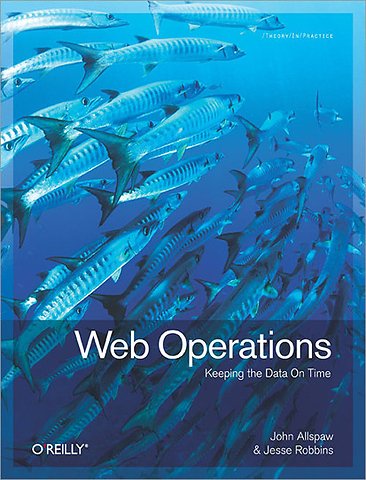


John Allspaw is currently Operations Engineering Manager at Flickr, the popular photo site.
Meer over de auteursWeb Operations: Keeping the Data on Time
Samenvatting
A web application involves many specialists, but it takes people in web ops to ensure that everything works together throughout an application's lifetime. It's the expertise you need when your start-up gets an unexpected spike in web traffic, or when a new feature causes your mature application to fail.
In this collection of essays and interviews, web veterans such as Theo Schlossnagle, Baron Schwartz, and Alistair Croll offer insights into this evolving field. You'll learn stories from the trenches-from builders of some of the biggest sites on the Web-on what's necessary to help a site thrive.
- Learn the skills needed in web operations, and why they're gained through experience rather than schooling
- Understand why it's important to gather metrics from both your application and infrastructure
- Consider common approaches to database architectures and the pitfalls that come with increasing scale
- Learn how to handle the human side of outages and degradations
- Find out how one company avoided disaster after a huge traffic deluge
- Discover what went wrong after a problem occurs, and how to prevent it from happening again
Contributors include:
- John Allspaw
- Heather Champ
- Michael Christian
- Richard Cook
- Alistair Croll
- Patrick Debois
- Eric Florenzano
- Paul Hammond
- Justin Huff
- Adam Jacob
- Jacob Loomis
- Matt Massie
- Brian Moon
- Anoop Nagwani
- Sean Power
- Eric Ries
- Theo Schlossnagle
- Baron Schwartz Andrew Shafer
Specificaties
Over Jesse Robbins
Inhoudsopgave
Preface
1. Web Operations: The Career
-Why Does Web Operations Have It Tough?
-From Apprentice to Master
-Conclusion
2. How Picnik Uses Cloud Computing: Lessons Learned
-Where the Cloud Fits (and Why!)
-Where the Cloud Doesn't Fit (for Picnik)
-Conclusion
3. Infrastructure and Application Metrics
-Time Resolution and Retention Concerns
-Locality of Metrics Collection and Storage
-Layers of Metrics
-Providing Context for Anomaly Detection and Alerts
-Log Lines Are Metrics, Too
-Correlation with Change Management and Incident Timelines
-Making Metrics Available to Your Alerting Mechanisms
-Using Metrics to Guide Load-Feedback Mechanisms
-A Metrics Collection System, Illustrated: Ganglia
-Conclusion
4. Continuous Deployment
-Small Batches Mean Faster Feedback
-Small Batches Mean Problems Are Instantly Localized
-Small Batches Reduce Risk
-Small Batches Reduce Overhead
-The Quality Defenders' Lament
-Getting Started
-Continuous Deployment Is for Mission-Critical Applications
-Conclusion
5. Infrastructure As Code
-Service-Oriented Architecture
-Conclusion
6. Monitoring
-Story: "The Start of a Journey"
-Step 1: Understand What You Are Monitoring
-Step 2: Understand Normal Behavior
-Step 3: Be Prepared and Learn
-Conclusion
7. How Complex Systems Fail
-How Complex Systems Fail
-Further Reading
8. Community Management and Web Operations
9. Dealing with Unexpected Traffic Spikes
-How It All Started
-Alarms Abound
-Putting Out the Fire
-Surviving the Weekend
-Preparing for the Future
-CDN to the Rescue
-Proxy Servers
-Corralling the Stampede
-Streamlining the Codebase
-How Do We Know It Works?
-The Real Test
-Lessons Learned
-Improvements Since Then
10. Dev and Ops Collaboration and Cooperation
-Deployment
-Shared, Open Infrastructure
-Trust
-On-call Developers
-Avoiding Blame
-Conclusion
11. How Your Visitors Feel: User-Facing Metrics
-Why Collect User-Facing Metrics?
-What Makes a Site Slow?
-Measuring Delay
-Building an SLA
-Visitor Outcomes: Analytics
-Other Metrics Marketing Cares About
-How User Experience Affects Web Ops
-The Future of Web Monitoring
-Conclusion
12. Relational Database Strategy and Tactics for the Web
-Requirements for Web Databases
-How Typical Web Databases Grow
-The Yearning for a Cluster
-Database Strategy
-Database Tactics
-Conclusion
13. How to Make Failure Beautiful: The Art and Science of Postmortems
-The Worst Postmortem
-What Is a Postmortem?
-When to Conduct a Postmortem
-Who to Invite to a Postmortem
-Running a Postmortem
-Postmortem Follow-Up
-Conclusion
14. Storage
-Data Asset Inventory
-Data Protection
-Capacity Planning
-Storage Sizing
-Operations
-Conclusion
15. Nonrelational Databases
-NoSQL Database Overview
-Some Systems in Detail
-Conclusion
16. Agile Infrastructure
-Agile Infrastructure
-So, What's the Problem?
-Communities of Interest and Practice
-Trading Zones and Apologies
-Conclusion
17. Things That Go Bump in the Night (and How to Sleep Through Them)
-Definitions
-How Many 9s?
-Impact Duration Versus Incident Duration
-Datacenter Footprint
-Gradual Failures
-Trust Nobody
-Failover Testing
-Monitoring and History of Patterns
-Getting a Good Night's Sleep
Appendix: Contributors
Index
Anderen die dit boek kochten, kochten ook
Net verschenen
Rubrieken
- aanbestedingsrecht
- aansprakelijkheids- en verzekeringsrecht
- accountancy
- algemeen juridisch
- arbeidsrecht
- bank- en effectenrecht
- bestuursrecht
- bouwrecht
- burgerlijk recht en procesrecht
- europees-internationaal recht
- fiscaal recht
- gezondheidsrecht
- insolventierecht
- intellectuele eigendom en ict-recht
- management
- mens en maatschappij
- milieu- en omgevingsrecht
- notarieel recht
- ondernemingsrecht
- pensioenrecht
- personen- en familierecht
- sociale zekerheidsrecht
- staatsrecht
- strafrecht en criminologie
- vastgoed- en huurrecht
- vreemdelingenrecht





